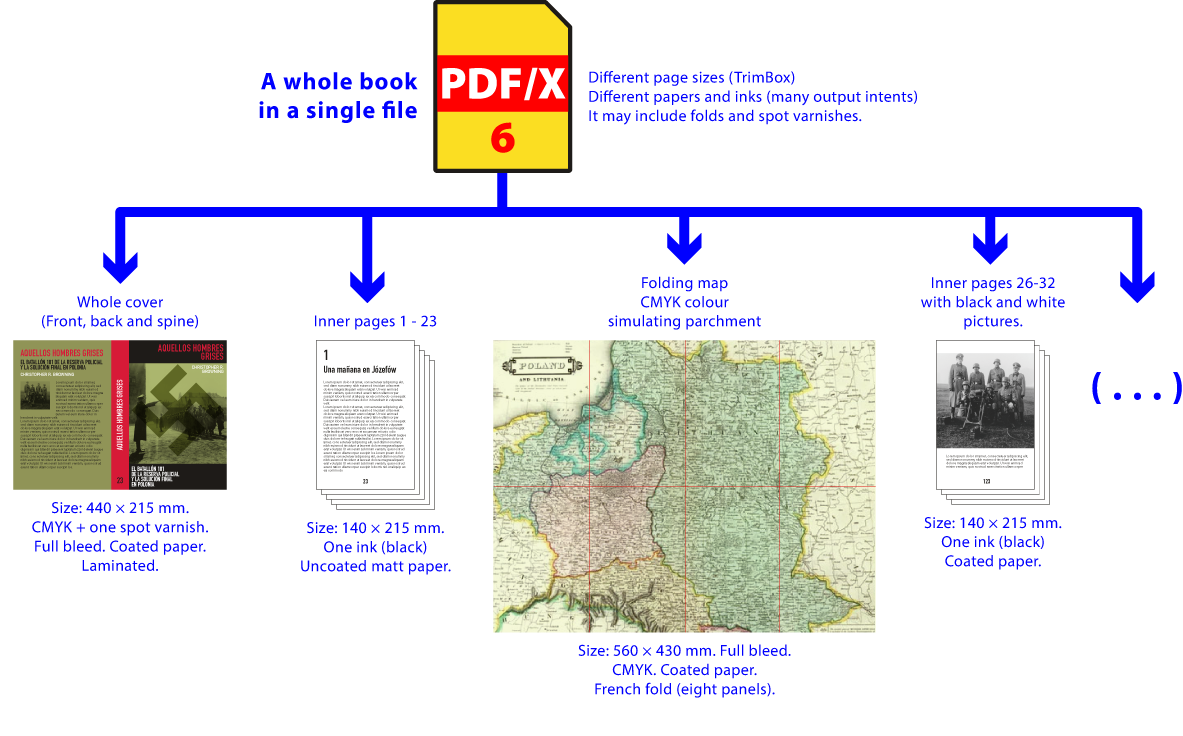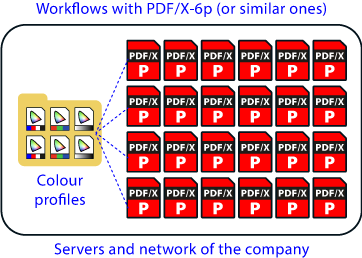Summed up in one sentence: The future of PDF/X. Compared to the other levels of PDF/X, it is an exponential leap (it is based on PDF 2.0) but the software ready for it is scarce.
The main issue with the PDF/X-6 standard, released in 2020, is that it does not have yet much real world application. Many of its improvements depend on features inherent to level 2.0 of the PDF format. Its basic aim is to take advantage of the flexibility allowed by this level of the PDF format and, interacting with other standards such as JDF, automate the application of variable data, printing on different substrates, use of different page sizes in the same document, better handling of spot colours, etc.

So, for example, PDF/X-6 allows a book to be sent as a single file, even if it has different parts with very different printing needs (laminated covers with spot varnish and CMYK, one ink pages, a folded map, coated paper pages with pictures, etc.). The idea is that each part of the document identifies itself and the machinery processes it appropriately, thus saving a lot of production time.
The PDF/X-6 standard was published in 2020, and has only one revision:
PDF/X-6:2020
It has two variants (PDF/X-6p and PDF/X-6n), which we review at the end of this page.
What's new
These are the main new features of the PDF/X-6 standard. For details on what is allowed and forbidden from previous versions, please see the page about the previous PDF/X-4 standard.
PDF format level: The use of PDF format level 2.0 is mandatory. No other levels are allowed. This change is much more important than it seems, as this PDF level itself allows and forbids many more things than previous levels, although the existing software does not apply many of these features.
Warning: The new PDF Level 2.0 features are optional. This means that any software not ready will ignore them.
Security: Unlike previous standards, which did not allow any security measures, PDF/X-6 allows the use of digital signatures with certain restrictions. The idea is that a document can be certified as long as this does not change its appearance.
Interactivity: Annotations, interactive forms (even in printable areas) and actions are allowed in PDF/X-6 but with some restrictions (mainly as long as their execution does not change the appearance of the pages).
Hidden or visible but not printable annotations are not allowed. XFA (XML-based) forms are also disallowed.
Metadata: The use of metadata trees to identify parts (pages and page groups) of the document, called "DPart metadata", now natively included in PDF level 2.0, is accepted. This Dpart metadata can also be used for automated manipulation of groups of pages with different characteristics (e.g. page size or inks used).
A second consequence is the acceptance of the PDF/VT-3 sub-standard for automated variable data printing (up to now, the use of this possibility was done with the PDF/VT-1 (in PDF/X-4) and PDF/VT-2 (in PDF/X-5) subsets).
The main organisations in the sector (CIP4 in particular) are providing and improving provided a standardised set of this metadata to facilitate the automated handling of jobs along the production chain.
Aside, the traditional "Info" dictionary ceases to exist (it is obsolete). From now on, general document metadata are placed only in the "Catalog" dictionary, in a "Metadata" dictionary, which uses a XMP structure.
Colours and inks: The standard adds the possibility of defining spot colours with the CxF-4 standard, which allows colours to be described using spectral measurement data on different substrates.
Mixing hints for spot colours are admited.
Both possibilities greatly improve the production of colour proofs and printed reproduction on customised packaging and labels.
Black point compensation (BPC), as described in an ISO standard since 2015, is allowed. This compensation is the adaptation of the maximum black tone levels in the file to those possible in the final reproduction system (in this case printing).
Pages and dimensions: In multipage documents, different page sizes are allowed, each defined by the corresponding page boxes; that is: The same box can have different sizes on each page.
Prepress: The use of arbitrary spot functions and the definition of the Halftone Origin Entry (HTO) are allowed. Both have been improved in this PDF 2.0 level.
Printing and reproduction systems: Multipage documents can have more than one output intent. One per page and one per document are allowed and they can all be different.
If there is no general document output intent, each page must have its own. If there is a document output intent, a page output intent is optional. In reproduction and printing, page output intents always override document output intents.
The ICC colour profile of the output intent used (page or document) is the transparency blending colour space to be applied at that level (page or document).
The ‘P’ variant: PDF/X-6p
This standard has a variant with the suffix "p" (the "p" stands for "partial"), which is intended for closed working systems, which do not receive materials from the outside and where the components are always the same or come from the same place, for example. This kind of partial variant exists since the PDF/X-4 level of the standards.

In this kind of files, the colour profiles in use cannot be not included in the document. They must be referenced by tags pointing to an external and known location on the server, where they must stored. Not even the colour profile that defines the printing aim (the output intent) can be included.
As these closed systems do not receive materials from outside, the components are always the same, and are 100% under control. This allows transfering a huge amount of colour profiles, with its subsequent weight, making their management more efficient.
The ‘N’ variant: PDF/X-6n
There is a second variant with the suffix "n" (the "n" stands for "n-colourant", i.e. an arbitrary number of colourants), to allow the use of multitone or extended gamut colour profiles, which allow separations of five or more inks, and which are used in printing systems such as CMYKOGV.
As with PDF/X5-n, the reason for the existence of this variant is that PDF levels 1.7 and 2.0 do not allow multitone colour profiles to be included in an output intent, so these ‘n’ variants allow such colour profiles to be referenced as external links (similar to the PDF/X-6p variant for other reasons).
Any job with spot colours that is also to be printed on a digital press capable of CMYKOGV printing (which cannot use spot colours but has a very wide colour gamut), will benefit from using the PDF/X-6n variant, as the 7-colour separation will not lose as much tonal range (if any).
Standards that define it
PDF/X-6 (and its variants) are defined in ISO 15930-9:2020. PDF level 2.0 is defined in ISO 32000-2:2020.
[© Gustavo Sánchez Muñoz, 2025] Gustavo Sánchez Muñoz (also identified as Gusgsm) is the author of the content of this page. Its graphic and written content can be shared, copied and redistributed in whole or in part without the express permission of its author with the only condition that it cannot be used for directly commercial purposes (that is: It cannot be resold, but it can form part as reasonable quotations in commercial works) and the legal terms of any derivative works must be the same as those expressed in this statement. The citation of the source with reference to this site and its author is not mandatory, although it is always appreciated.